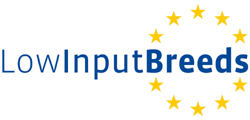Subproject 4
Improving performance, animal health & welfare, environmental impact and product in organic and ‘low input’ LAYING HEN production systems
Responsible
- Dr. Ferry Leenstra, Wageningen University and Research Centre, Livestock Research, The Netherlands

- Dr. Veronika Maurer, Research Institute of Organic Agriculture, Switzerland
 (Deputy)
(Deputy)
Work packages
Laying hens (subproject 4)
The aim of subproject 4 is to improve performance, animal health & welfare and product quality in organic and ‘low input’ LAYING HEN production systems. The work is organised in three work packages.
Main issues
The main issues addressed under Subproject 4 are:
1. Animal behaviour problems
Animal behaviour problems (e.g. feather pecking, smothering, nesting behaviour and associated mortality rates) cause significant economic losses in organic and other free range, ’low input’ sys-tems. Behaviour problems were observed to increase when (a) imbalanced diets are used (e.g. in organic production systems an appropriate balance of essential amino acids may be difficult to achieve) and/or (b) animal health is affected (e.g. by parasites and diseases). These animal wel-fare issues may significantly affect demand for organic and free range eggs, when recognized by consumers.
2. Diseases and parasites
Diseases and parasites continue to cause significant economic losses. These health problems may increase under free range husbandry systems, due to a greater risk of cross infection from environmental sources (e.g. via contact with wild birds/mammals and their faeces).
3. Ethical issues
Ethical issues increasingly recognized include the need to discard male chicks (which are unsuitable for meat production) and of laying hens after one production period/year (due to a lack of markets for their meat). Prolonged laying periods and/or moulting might reduce these problems, but there are concerns that hens experience stress and cruelty due to management practices during the moulting procedure.
4. Sensory and nutritional quality of eggs
Relatively little R&D has focused on nutritional quality characteristics of eggs in organic and free range systems. However, pilot studies indicate that the levels of vitamin E and omega-3 fatty acids in eggsand poultry meat increase significantly in extensive free range and/or organic systems. There is extensive experience within breeding companies on selection for egg size, shell strength and colour (which are important sensory quality characteristic in the ’low input’ sector, where there is virtually no market for second grade eggs). There may also be interactions between sensory and nutritional quality characteristics, but no information is currently available.
5. The shelf life of eggs from organic and some free range systems
The shelf life of eggs from organic and some free range systems was reported to be lower than that of conventional in-door produced eggs, by egg merchants/supermarket buyers consulted during the preparation of the project; some work will therefore also focus on identifying the effect of layer genotypes and storage conditions of the shelf life of eggs.
6. Lack of ‘low input’ focused breeding experience and infrastructure
Organic and ’low input’ egg production is currently based on the same genetic lines (produced worldwide by two main breeding companies) as intensive egg production. Adoption of traditional breeds is currently not feasible for commercial organic and free range ‘low input’ egg production, due to their low productivity. In this project we will therefore focus on genotypes available from the main breeding companies. However, if crossbreeding with traditional breeds is shown to be promising in other project, this knowledge will be incorporated. Some crosses appear to perform better in organic systems than others, but knowledge on how to obtain genotypes specifically suited for organic (free range) egg production is not currently available.
Work under subproject 4
Work under subproject 4 is subdivided into three main workpackages:
- WP 4.1 Development of ‘FARMER PARTICIPATORY’ breeding systems to improve productivity, health and welfare and egg quality related traits; comparing standard with farmer participatory breeding systems
- WP 4.2 Effect of, and interactions between, laying hen genotypes, feeding regimes, ‘welfare-friendly’ moulting protocols and prolonged use of layers on performance, and animal health and welfare
- WP 4.3 Effect of, and interaction between, laying hen genotypes and management innovations on egg quality
 This website was archived on December 19, 2017 and is no longer updated.
This website was archived on December 19, 2017 and is no longer updated.


